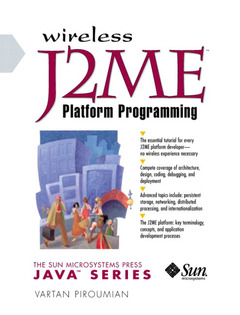(NOTE: Each chapter concludes with a Summary.)
Foreword.
Preface.
Acknowledgments.
Introduction.
1. Introduction to the Java 2 Micro Edition (J2ME) Platform.
Defining a Java Platform for Pervasive Devices. Configurations and Profiles. The Connected Device Configuration (CDC). Connected, Limited Device Configuration (CLDC). Device Application Management Systems.
2. The MIDP Application Development Process. Designing and Coding. Compilation. Preverification. Packaging. Creating the JAR Manifest File. Creating the MIDlet Suite JAR File. Creating the MIDlet Suite Application Descriptor File. Deployment and Execution. Using the J2ME Wireless Toolkit. Creating a Project. Placing Source Code in the Project. Compiling the Project. Packaging the Project. Deploying the Application. Executing the Application.
3. MIDP Application Program Structure. The Application Execution Lifecycle. MIDlet Program Structure. The MIDlet State Model. The MIDP UI Component Model. System Properties. Application Properties.
4. The MIDP High-Level API. Command Processing. Command-Processing Scenario. Screen Navigation. Command Organization. Command Ordering. Command Semantics.
5. The MIDP UI Components. MIDP UI Component Hierarchy. Screens and Screen Elements. Screen Navigation. More Item Components. DateField. StringItem. Gauge. Ticker. ImageItem. One More Screen Type.
6. The MIDP Low-Level API. Command and Event Handling. Key Events. Game Actions. Graphics Drawing. The Graphics Model. The Graphics Class. Basic Geometric Drawing. Clipping. Translation. How Components Are Painted. Double Buffering. Image Display Using a Canvas.
7. Persistent Storage Support in MIDP. Device Support for Persistent Storage. RMS Data Storage Model. Records. An Example Application. Manipulating byte Data. Enumerations. Record Filters. Record Comparators. Record Listeners. Miscellaneous Record Store Features.
8. MIDP Networking and Communications. The MIDP Networking Model. The MIDP Generic Connection Framework. Connectors and Connections. Generic Connection Framework Classes and Interfaces. Stream Connections. Content Connections. Datagram Connections and Datagrams. Socket Connections. Differences between J2ME and J2SE Networking.
9. Internationalization. Concepts. Locales and Localization. Character Encoding Sets. Aspects of Internationalization. Internationalization Support in MIDP. I18N Frameworks. Messaging. String Collation. Date, Time, and Numeric Formatting. Calendar and Time Zone Support. Designing an I18N Solution for a MIDP Application. Using MIDlet Attributes to Define L10N Resources. Using Application Text Files to Define L10N Resources. Using Java Class Files to Define I18N Resources. Application Provisioning of L10N Resources.
10. Application Provisioning. Concepts. The Provisioning Process. Application Registration. Application Search. Compatibility Verification. Purchase Verification and Non-Repudiation. User Authentication. Application Software License Negotiation. Application Download. Application Installation and Installation Verification. Billing Event Generation. Application Update. Application Removal. Preparing Applications for Provisioning Systems.
11. The Wireless Internet Environment. Background, Terminology, and Concepts. The Wireless Application Environment. Wireless Applications. Messaging. Personal Information Management Applications. Personalization. Location-Based Services. Application Architecture. Architectural Frameworks. Systemic Qualities. Architectural Considerations for the Wireless Internet.
Appendix A. References. Glossary. Index. 




